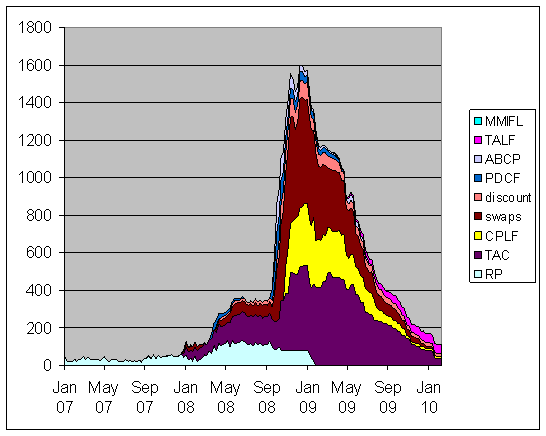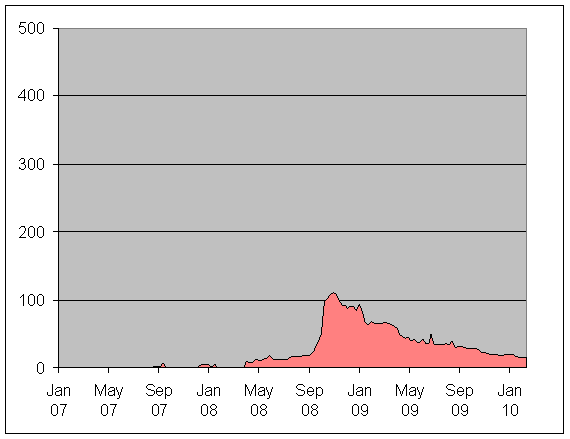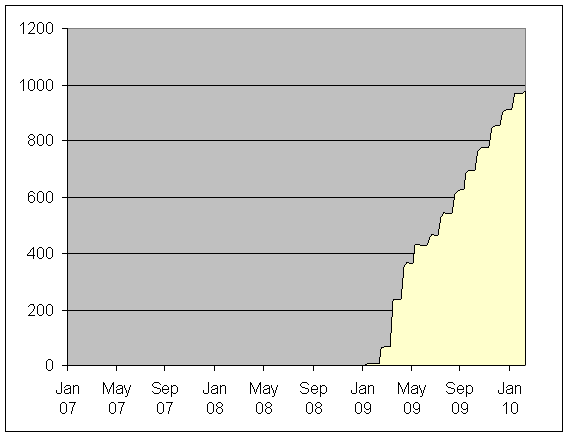The Federal Reserve Board announced on Thursday that it is raising the interest rate at which banks borrow from the Fed’s discount window to 0.75%, a 25-basis-point increase, and intends to return discount lending primarily to the traditional overnight loans. “The rate hike cycle begins,” declared 24/7 Wall St, and Business Week reported:
Treasuries fell, pushing yields to the highest levels in at least five weeks, amid concern the Federal Reserve’s increase in the discount rate signaled policy makers are moving closer to lifting benchmark borrowing costs.
But I don’t believe that’s what the discount rate hike means at all.
The Fed sometimes has used discount rate changes as a signal of its intentions for interest rates more broadly. But the Fed press release accompanying the move stated flatly that’s not the case this time:
The modifications are not expected to lead to tighter financial conditions for households and businesses and do not signal any change in the outlook for the economy or for monetary policy….
The same message was emphatically repeated in statements by Fed Governor Elizabeth Duke and Federal Reserve Bank of New York President William Dudley. Maybe you have a theory that the way the Fed communicates that it intends to raise rates is by denying that it intends to raise rates. If so, I can’t help you.
The Fed described its true intentions in the minutes of the Jan 26-27 FOMC meeting:
Staff briefed the Committee on current usage of the discount window and other liquidity facilities and suggested additional steps policymakers could take to normalize the Federal Reserve’s liquidity provision. These steps included continuing to scale back amounts offered through the Term Auction Facility (TAF); returning to the pre-crisis standard of one-day maturity for primary credit loans to all but the smallest depository institutions; and increasing, initially to 50 basis points from 25 basis points, the spread between the primary credit rate and the upper end of the Committee’s target range for the federal funds rate…
All of which the Fed has now implemented. The FOMC minutes also indicated that the purpose of a discount rate hike would be
discouraging depository institutions from relying on the discount window as a routine source of funds when other funding is generally available…. Participants generally agreed that such steps to return the Federal Reserve’s liquidity provision to a normal footing would be technical adjustments to reflect the notable diminution of the market strains that had made the creation of new liquidity facilities and expansion of existing facilities necessary and emphasized that such steps would not indicate a change in the Committee’s assessment of the appropriate stance of monetary policy or the proper time to begin moving to a less accommodative policy stance.
The Fed does not want to be lending to financial institutions on a permanent basis, and for this reason has been winding down the TAF and other lending facilities.

Subset of Federal Reserve assets, in billions of dollars, seasonally unadjusted, from Jan 1, 2007 to February 10, 2010. Wednesday values, from Federal Reserve H41 release. swaps: central bank liquidity swaps; MMIFL: net portfolio holdings of LLCs funded through the Money Market Investor Funding Facility; CPLF: net portfolio holdings of LLCs funded through the Commercial Paper Funding Facility; TALF: loans extended through Term Asset-Backed Securities Loan Facility plus net portfolio holdings of TALF LLC; ABCP: loans extended to Asset-Backed Commercial Paper Money Market Mutual Fund Liquidity Facility; PDCF: loans extended to primary dealer and other broker-dealer credit; discount: sum of primary credit, secondary credit, and seasonal credit; TAC: term auction credit; RP: repurchase agreements;
The Fed clearly sees winding down the level of discount window lending as part of the same process. Raising the discount rate and returning to one-day loans are the ways it intends to finish doing that.

Discount window lending by the Federal Reserve (sum of primary credit, secondary credit, and seasonal credit), in billions of dollars, seasonally unadjusted, from Jan 1, 2007 to February 10, 2010. Wednesday values, from Federal Reserve H41 release.
As I noted last week, despite phasing out various facilities, the Fed intends to allow its massive MBS holdings– an alternative form of long-term lending by the Fed– to decline only gradually. Choosing to sell off some of these would be an important signal that the Fed’s assessment of the economy and near-term plans have changed.
Raising the discount rate would not.

Mortgage-backed securities held outright by the Federal Reserve, seasonally unadjusted, from Jan 1, 2007 to February 10, 2010. Wednesday values, from Federal Reserve H41 release.
- Bulenox: Get 45% to 91% OFF ... Use Discount Code: UNO
- Risk Our Money Not Yours | Get 50% to 90% OFF ... Use Discount Code: MMBVBKSM
Disclaimer: This page contains affiliate links. If you choose to make a purchase after clicking a link, we may receive a commission at no additional cost to you. Thank you for your support!


Leave a Reply